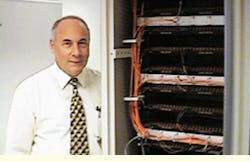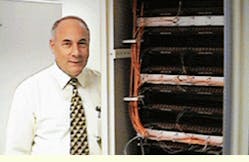Australian racing authority TABCORP upgrades with 12- and 24-fiber fiber-optic cable.
Barney Tomasich,
Anixter Australia
Racing is a way of life in Australia, and the biggest day on the racing calendar is the day of the Melbourne Cup. That`s when everyone on the entire Australian continent seems to stop to watch the famous race every November. TABCORP is the organization in Melbourne that coordinates the race-betting business. For TABCORP`s communications network to suddenly stop on Melbourne Cup Day would be an unthinkable nightmare, costing the company millions of dollars in lost revenue. To avoid such a catastrophe, TABCORP decided last year to upgrade its network, with special emphasis on redundancy and "bullet-proofing."
The upgrade involved two multistory buildings separated by two roads and a parkway. For the intrabuilding backbones, the existing copper cabling was stripped out and replaced by two 12-fiber multimode fiber-optic cables for data transmission. The interbuilding backbone consisted of two 24-fiber multimode fiber cables. All optical fibers were 62.5/125-micron and complied with the stringent iso/iec-11801 standard requirements for maximum attenuation (3.5 decibels per kilometer at 850 nanometers and 1 dB/km at 1300 nm) and minimum modal bandwidth (200 megahertz-kilometer at 850 nm and 500 MHz-km at 1300 nm). To accommodate voice transmission, eight enhanced Category 5 unshielded twisted 25-pair cables were also installed in the backbones.
Anixter Australia (Melbourne), a value-added provider of integrated networking and cabling equipment, teamed with its supplier partners--Lucent Technologies for structured cabling and hardware, 3Com for computer network equipment, and desa, an Australian-based cabling-installation contractor--to design, install, and performance test TABCORP`s entire cabling infrastructure. "One of the key requirements of TABCORP was to have a resilient network," explains Anixter Australia network designer Gavin Moores. "Thus, the supply of dual fiber runs to each floor was very important. The core switch was made as redundant as possible, with dual power supplies and dual switching engines."
A backup infrared, optical-fiber 10-megabit-per-second connection was installed on the roofs of the two buildings. The installation of this secondary data link involved dismantling the existing link and carefully aligning beacons on the buildings. Rooftop venting had to be cut in to provide a line-of-sight connection without affecting the architecture of the building.
The primary connection between the buildings was built using directional underground boring equipment, cutting a path from the basement of one building, under two roadways, and into part of a public park. Then a 100-millimeter underground conduit was installed to complete the route between the two buildings.
Design for minimum disruption
Horizontal cabling runs supported open-office architecture, with one important difference: A special ceiling consolidation point that could be pulled down for installation and inspection was designed by desa. Since TABCORP was experiencing high churn rates, the desa design ensured minimum disruption during moves, adds, and changes. With the restrictive requirement to use existing communications closets that measure 1200 x 1300 mm on each level, it was necessary to custom-manufacture two equipment cabinets to link the backbone and horizontal cabling as well as to hold the network equipment.
Lucent`s SYSTIMAX Structured Cabling System hardware was used for all the optical-fiber and copper horizontal and backbone cabling applications. Lucent warrantied the installation for 15 years, covering both TABCORP`s current and future applications. The backbone technology was 100Base-FX using 3Com Corebuilder 7000 switches.
The entire installation was tested with a Level II handheld tester and an optical time-domain reflectometer. desa used the Fluke dsp2000 and the Microtest PentaScanner+ to ensure that the cabling solution was fully compliant with local standards. The performance limits for Class D link and channel were based on the local standards handbook, saa/snz hb 27 Handbook for Field Testing of Communication Cabling. This handbook is based on telecommunications systems bulletin tsb-67, "Transmission Performance Specifications for Field Testing utp Cabling Systems," but incorporates iso/iec-11801 terminology for Class A-D link and channel specifications and attenuation-to-crosstalk ratio.
A team of about 10 technicians worked full-time to meet the specified deadline for the installation`s completion. Installation was considered complete when each user was operational. "It was a challenging task," reports desa`s Tony Noble, registered communications distribution designer (RCDD), who managed the entire TABCORP project. "We had to implement the project in a tight time frame, taking into account the design requirements of the open-office architecture and the limited space in the communications closets on each level."
The entire site was fully labeled in accordance with a local cabling-administration standard, as/nzs 3085.1, "Telecommunications Installation--Administration of Communications Cabling Systems." This standard is based on the tia/eia-606 Administration Standard for the Telecommunications Infrastructure of Commercial Buildings, but is not as complex.
The Standards Australia/Standards New Zealand CT/1/1 Integrated Cabling Systems for Buildings committee is responsible for issuing the country`s cabling standards. The committee saw that the tia/eia-606 document was one page short of War and Peace and believed that Australian cabling installers would not abide by it. The result was as/nzs 3085.1, a "no-frills" local standard that captured the essentials of administration, recording, and labeling. It forms the basis of an iso/iec administration standard expected to be published sometime this year.
Standing next to TABCORP`s new multimode-fiber backbone racking connection is Peter Hollier, the race-track betting company`s on-course and systems wagering manager.
A hinged door in the ceiling is opened to show a consolidation point consisting of a 110 block connection for TABCORP`s premises-cabling system.
Barney Tomasich, RCDD, market development manager for structured cabling systems, Anixter Australia (Melbourne), is chairman for Standards Australia/Standards New Zealand CT/1/1 Integrated Cabling Systems for Buildings committee. He is also Australia`s representative on the international iso/iec jtc-1/sc-25/wg-3 Customer Premises Cabling committee.


